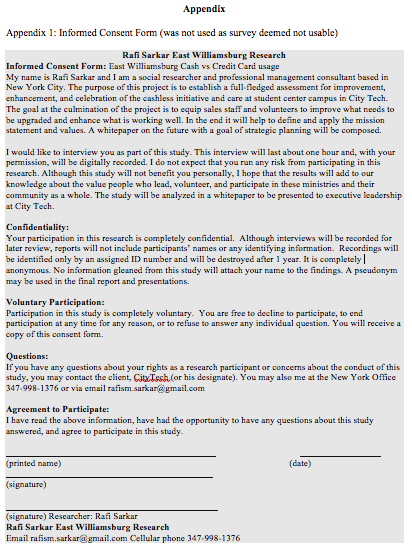Abstract
The COVID-19 pandemic has brought much of the world to stand still, where the health crisis has shown and magnified the ongoing financial crisis of everyday people. Additionally, the restriction-enforced dye to the virus has also magnified the disparity in news and available information. The purpose of this research is to view the way people wear and use masks and face coverings. Currently, we are faced with a pandemic that requires people to change their habits for the sake of the community. If people were not to follow through with consensus, what are the repercussions and does that make a difference. It is extremely unusual to see the needs of the people versus what information can be found through a media outlet. Although the first assumption is that there would far more turnout and heavy traffic in supermarkets, the reality appears to be otherwise.
Research Field
The COVID-19 pandemic has brought much of the world to stand still, where the health crisis has shown and magnified the ongoing financial crisis of everyday people. Additionally, the restriction-enforced dye to the virus has also magnified the disparity in news and available information. In the beginning, masks were recommended to be used by symptomatic persons, and now it is a requirement for anyone to step out.
The neighborhood falls into to distinctive area crossed by Bushwick Avenue to the east of it is Williamsburg to the west of it is East Williamsburg. If I walk towards the east Williamsburg Section on Johnson Ave, it is predominantly, a desolate area filled with mostly commercial spaces. However, with further inspection, there are quite a few art galleries, cafés, specialty restaurants. A block over you finds a roll of bars, party halls, and clubs. Even with further inspection two blocks down, you find specialty Coffee shops such as the city of Saint coffee roasters; or you find pizzeria like Roberto‘s; or famous restaurants like Bianca or ICHIRAN Ramen. The demographic appears to be fairly affluent Young Professionals who have discerning taste and lure of how things should be presented and perceived. It is filled with natural looks and tastes and flavors. It is fairly dominated by cashless a place that caters to that whole idea of not tracked or catering to smaller mom and pops/artisanal businesses.
If I walk on the West of Bushwick Avenue Ave. on Williamsburg section is dominated by cheap restaurants and eateries some shops that are reminiscent of old Brooklyn bodegas, cheap shops where you can get very quick food, street vendors who are selling hotdogs and one dollar pieces of ice. The homes are not new but small. They have the old worn out nook, mostly populated by older generations. Further down you see the whole cluster of project buildings and churchgoers that are directed by signs of wonders service. There is a whole row of Spanish eateries and grocery shops. Even further down, you are taking two avenues of Puerto Rico where it is dominated by Mexican restaurants and Spanish pastry shops. The music is loud and full of meringue gay and Bachata. The most population appears to be of Hispanic race or Mexican background. Even further down there are many Chain restaurants such as McDonald’s and Dunkin’ Donuts. Instead of a small shop, you are faced with large conglomerate supermarkets such as the K market and associated market.
The area is totally divided into two different atmospheres and people and social gatherings. One section catering to the affluent nature and affluent changer of the neighborhood who are moving into an area filled with luxury buildings, shopping in places that are expensive and has shiny look to it. In the other section, it is inexpensive groceries, bodegas, and Chinese food restaurants. This area is not attractive nor has any sense of beauty. However grungy eight might be, it appears to be New York… The true New York where people are living within the family and within a community, in New York where you can find inexpensive items as much is really expensive items, a New York where you are in the midst of everything but protected because people in the community are looking out for you.
Major Research Proposal
Currently, we are faced with a pandemic that requires people to change their habits for the sake of the community. If people were not to follow through with consensus, what are the repercussions and does that make a difference.
Professional Background & Quantitative Approach
My background is in operation. I create a strategy after reviewing customer’s and employees’ behavior to create a process to curve behaviors to maximize sales and minimize loss. I chose this research question to understand how people think, feel, and act based on surrounding, available information, suggestions from peers/community, and requirements/restriction applied by law. to me, it seems external requirements and laws are ineffective on its own, however, social pressures may have more impact on a person’s behavior over the fear of penalty from law. I am counting where and types of establishments has the most amount of people and how many people are wearing masks I will be walking around the neighborhood at a certain time of the day to see how many people I encounter and how many people are wearing the mask.
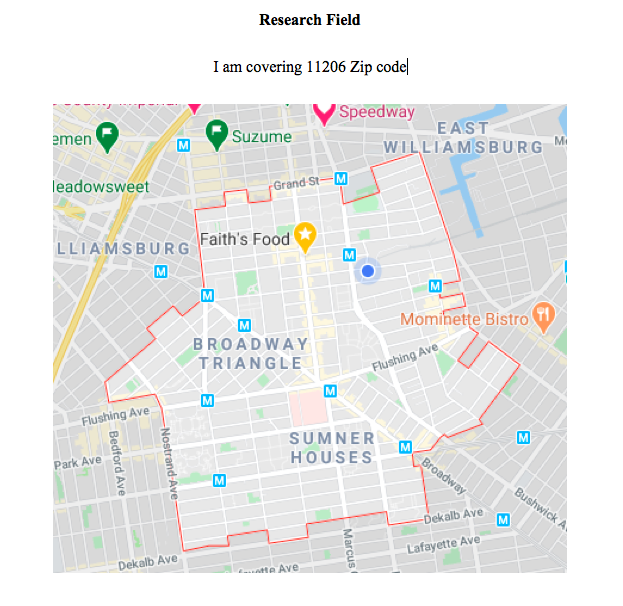
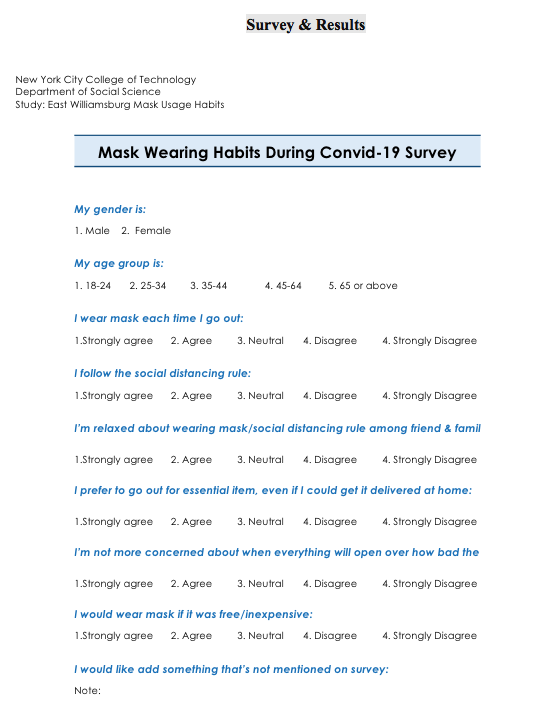
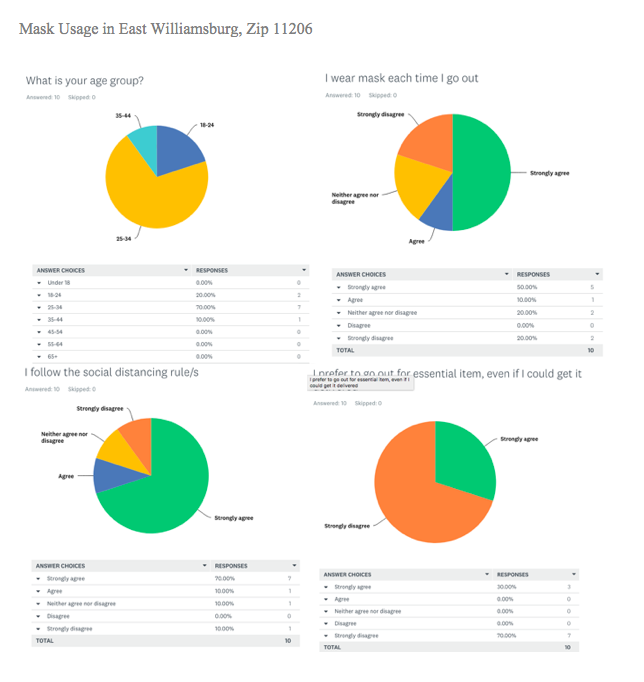

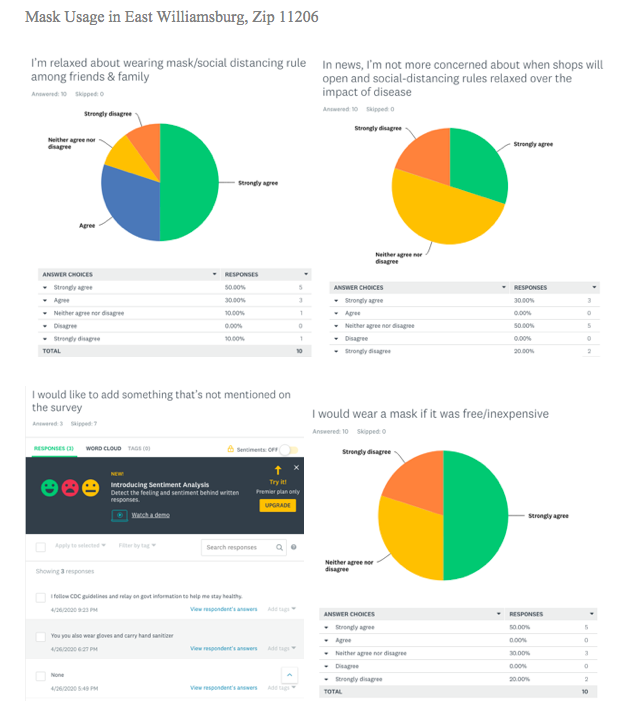
Total Frequency Count For Four Days
My research was in two weeks from 2pm to 4pm visiting 6 locations. Observing line formation and the usage of mask by people; the observation was to capture the race, age, body size, gender, and the ability to wear mask, not being present, and inappropriate use or not being used even when mask is present.
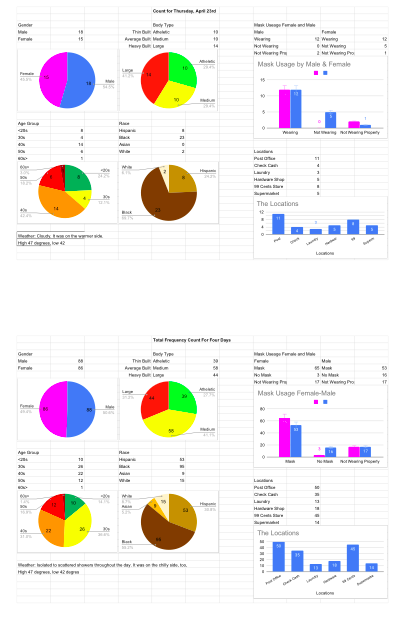
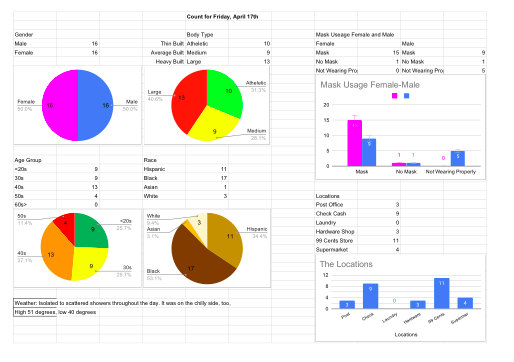
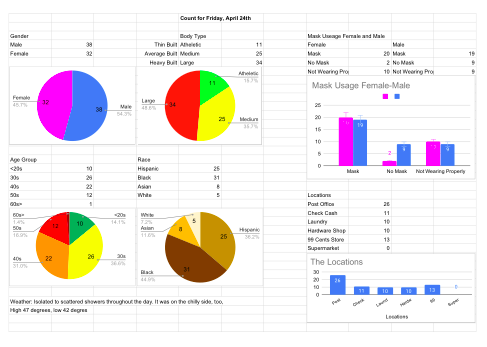
Annotated Bibliography
Andrew, S. C. (2020, May 6). Although Government and businesses are requiring people to wear a mask, people’s rebellious nature is making them act otherwise because they never had to wear masks before. However, Americans should think of the mask as a necessary act of solidarity. And yet, for some, this rule may feel like forfeiture of their freedoms. On the other hand, for some, wearing a mask means admitting a fear they may not have consciously confronted yet: Some think it could make them look weak, and wearing one could signal the person as labeled a “scared cat”. For others, the guidance is confusing: Within three months, masks went from unnecessary for healthy people to recommended for anyone who goes out in public. People who followed the CDC’s initial advice — to avoid wearing a mask if you’re healthy — may have felt cheated or wronged when the CDC recommended them in mid-April. There are also mixed messages at the federal level: While the CDC recommends the public wear masks, President Donald Trump didn’t wear a mask during a visit to a Honeywell mask factory. On the other hand, there are those who won’t wear it because it is uncomfortable: people tend to seek out rituals that make them feel secure and wearing masks in public isn’t one of them. When people are told what to do, and it’s not the conforming, usual way to behave, there’s a tendency to question that and to resist.
North, A. (2020, April 30). While larger companies have begun mass-producing cloth masks in recent weeks, much of the work of making the protective garments, especially in the early stages of the pandemic, was done at home — often by women. That gender breakdown is continuing in some volunteer efforts — about 85 percent of the around 70 volunteers sewing masks for the New York City-based group Face Mask Aid, for example, are women. The demands of daily life during the coronavirus pandemic are many, from shopping for food amid shortages and virus fears to caring for children when schools and daycares are closed. And in many cases, women are the ones figuring out how to meet those new demands. Across the board, women seem to be doing a disproportionate share of the work to keep people safe, fed, and cared for during this pandemic. And they’re often doing it without proper recognition or compensation. Overall, it’s laudable that women have often stepped up in times of crisis to use their skills and help others. But that willingness to pitch in should not be taken for granted.
Taylor, D. B. (2020, April 14). African-American men worry that following the C.D.C. recommendation to cover their faces in public could expose them to harassment from the police. The fear is the person could draw unwanted attention by wearing a mask in public. s the coronavirus continues to spread, infecting and killing African-Americans at disproportionately high rates, black men find themselves facing two concerns: the virus and those who see their covered faces as threatening. In March, before the C.D.C. issued its recommendation, two black men in surgical masks filmed themselves as a police officer was kicking them out of a Walmart in Wood River, Ill. It is unclear how many profiling incidents there have been since the C.D.C. issued its recommendation earlier this month: the pandemic and the C.D.C.’s mask recommendation, however well-intentioned, could put African-Americans at greater risk.
Bittle, J. (2020, April 4). As the coronavirus spreads throughout the United States, the Postal Service has struggled to maintain its crucial role in connecting the country, while also protecting its workers and customers. These challenges are not limited to disinfecting surfaces or social distancing, either: Many post offices have long been understaffed, and the coronavirus is poised to push an already overworked labor force to a breaking point. The rapid spread of the coronavirus caught many industries in the United States by surprise, but postal workers said the response at their stations has been particularly slow and ineffective. Half a dozen clerks and carriers told me that management has not been able to provide soap, disinfectant wipes, and hand sanitizer, or gloves for postal carriers. As the coronavirus tax staffing levels, the two postal unions, and postal management are scrambling to find a way to keep workers safe without compromising the agency’s essential function. If Congress does not take further action to save the Postal Service in the near future may come to pass, and its consequences would be dire. Without a functioning Postal Service, there would be no one to deliver medicine, medical supplies, and protective equipment to households and hospitals around the country, especially in more remote places. As more states and cities go on lockdown, families will also rely on the USPS to deliver packages full of any food and hygienic supplies they may not be able to find in grocery stores. There are some customers who look forward to male delivery or postal visits. That might be their only human contact the entire day. It lets them breathe a little bit easier, like, all right, things are bad, but we still have some sense of stability going on.
Aubrey, A. (2020, April 18). As data emerges on the spectrum of symptoms caused by COVID-19, it’s clear that people with chronic health conditions are being hit harder. While many people experience mild illness, 89% of people with COVID-19 who were sick enough to be hospitalized had at least one chronic condition. The CDC found that 33% of people who’ve been hospitalized with COVID-19 are African American, yet only 13% of the U.S. population is African American. Some local communities have found a similar pattern in their data. Among the many (26) states reporting racial data on COVID-19, blacks account for 34% of COVID deaths, according to research from Johns Hopkins University. This disproportionate toll can be partially explained by the fact that there’s a higher prevalence of obesity, high blood pressure, and diabetes among African Americans compared with whites. There are several factors, including some genetic ones, which may make African Americans are more vulnerable to COVID-19. There have been a few studies that have pointed to African Americans potentially having genetic risk factors that make them more salt-sensitive. Another issue to consider may be high-stress levels: when a person experiences racial discrimination, it can contribute to chronic stress. She points to several studies that link discrimination and stress to higher levels of inflammation among black adults.
Quantitative Methodology and Results
What race is prevalent in East Williamsburg?
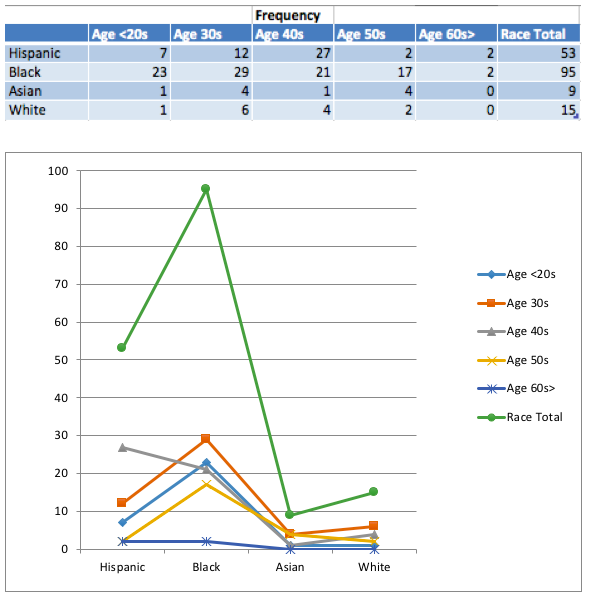
The impression of East Williamsburg is that it is predominantly very young in their 20s, mostly Caucasian demographic. However, though this count it appears to be mostly African American and people who are in their 30s.
Where did more people spend time?
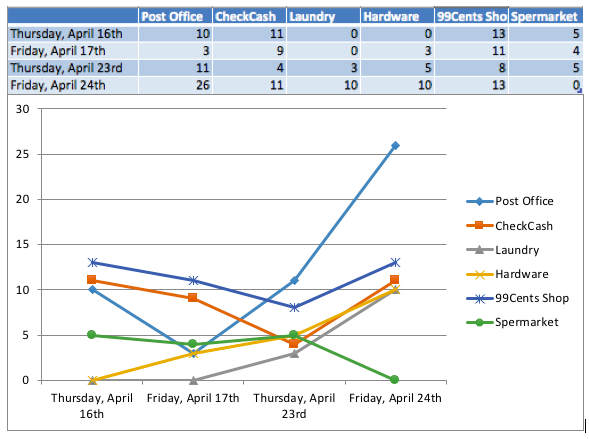
It is extremely unusual to see the needs of the people versus what the information can be found through media outlet. Although, the first assumption is that there would far more turnout and heavy traffic in supermarket, the reality appears to be otherwise. It is very surprising to find that Post Office superseded all other essential establishments, with 99 Cents Store trailing closely. It could be said that those locations are understaffed, or that people feel the need to reach other others and looking for inexpensive household products.
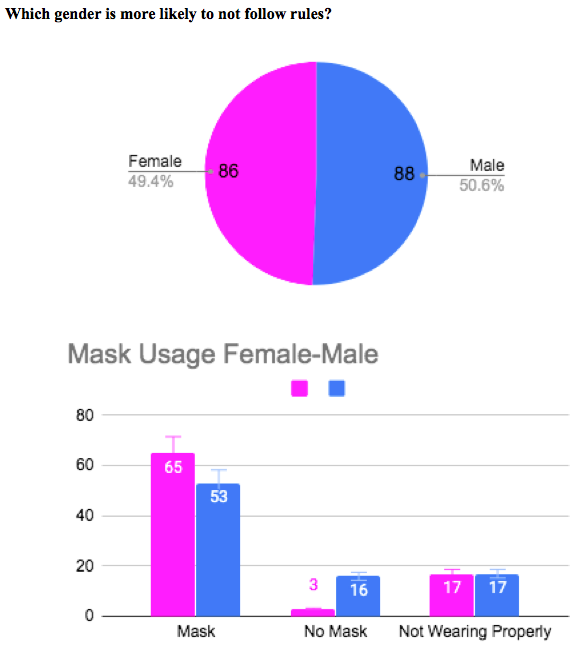
The headcount is very close with man over taking only by 2 persons. The headcount points out men are more likely to not wear any mask, where very few women are to follow men’s practice of not wear any form of face coverings. It could be said that culturally it is presumed that women are safer than men and this count would appear to support that common belief and notion.
Qualitative Methodology and Results
The research focused on 5 specific locations in East Williamsburg. These locations were selected due to my findings during the literature review of essential services requiring attention. It is to be noted that these are the mainstay storefront in this area and spacious enough to support a fairly large crowd, however, prior to the restriction brought up in response to Covid19, I have never experienced any lines or any of the shops ever having large crowd or long wait time. Aside from the demographics, I mainly focused on people’s usage of masks versus location versus weather. It is to be noted that, all of these locations required every customer and potential customer to wear a mask in order to gain access to its facilities and products, however, if a person did not have one, the location was providing it with no extra charge/ cost to its visitors. Additionally, I conducted the review during Thursday and Friday specifically from 3 pm to 5 pm because my presumption was and is that most people, who are forced to be home, feel the need to step out later during the day due to feeling “locked-up”, or remembering a service and product need, or/and the need to go for a walk. From the research and counting, I have able to find that weather patterns did not have any effect on the frequency of visitors. Additionally, there was the negligent amount of difference in the number of people divided by gender identities and gender roles.
Coding & Results
The surprising fact is that, although my focus was on the mask usage of people in a certain establishment, I have encountered numerous people who were not visiting those establishments and were not using a mask or a mask appropriately. In my observation, the young men I have encountered were mostly African-Americans who did not sport a mask. This the action was also observed in my literature review, where it is easy to point out that most men of color felt both fearful of racial objectification and bias if they were to hide their face because of the preconceived belief that a man of color is usually hiding his face when he is engaging in illicit behaviors.
Additionally, the common denominator of the finding is that most women were practicing safer mask usage, while the men were following social distancing rules. The amusing part of this finding is that both of these actions are not recommended by CDC, and disparity appears when there is a mask present, however, failing to wear it in the appropriate safe manner. From literature research, it is pointed out that women tend to be more protective of health and wellbeing, and are more inclined follow rules and support the needy based on their maternal nature in addition to their responsibility family and children. This would conclude that each gender chooses to follow certain aspects of the mask usage rules based on the needs and wants.
Lastly, it could also be pointed out that the majority of the people were older African-American and Hispanic, and not Caucasian, even though this gentrified section is predominantly made out of affluent young adults. Potentially, it could be due to the nature of the available resources and services available to people of the different socioeconomic groups. Most new buildings in the neighborhood have full service, where all essential services (picking up and dropping of mail, groceries, laundry, medications, and emergency household repairs) are available to them. Additionally, the majority of the new buildings boast full-services wherewith the building a gym is an available and outdoor space on the roof to make people feel very comfortable. It could be pointed out that the pandemic is showing the disparity in wealth and resources available to a person in need versus a person of means. It also could be pointed out that behaviors most people would consider unsafe are done because of the way the culture is set up and manifested. It could be said that to minimize the danger, services should be available equally.
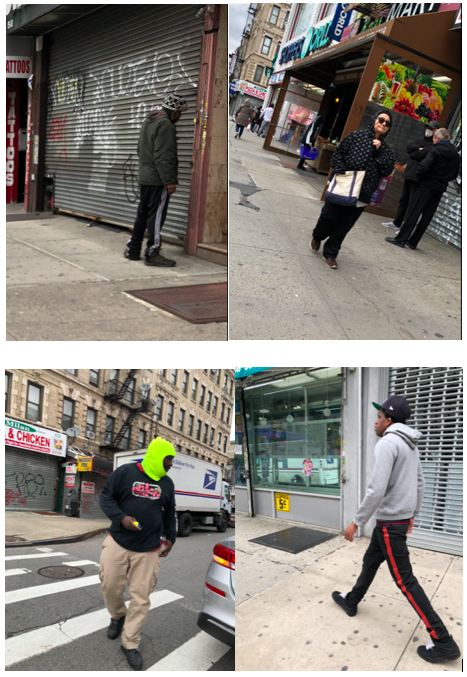
Implications and Recommendations.
The COVID-19 pandemic has brought much of the world to standstill, where the health crisis has shown and magnified the ongoing financial crisis of everyday people. Additionally the restrictions enforced due to the virus have also magnified the disparity in news and available information. At the beginning masks were recommended by authority to be used by symptomatic persons, and now it is a requirement for anyone to step out. However, due to demand, it is almost impossible to buy masks. The underprivileged are then forced to step out without mask. Additionally, online shopping of essential items does not offer any sort of discounts, so this also becomes a need for certain demographics to be going outdoor in spite of restrictions. For there to be any viable way to enforcement of mask usage, there has to be a way to measure what sort of resources are available to people, and in the case, the person/s is not able to follow rules and regulations due to having limited resources, there has be a way to provide resources to that person, so they might be in compliance. No matter how to do research and look/count people based on demographics, one gender/race will always trump another due other external factor that is not counted in a research. For the research conclusion to be fully conclusive, and accountable, a social research must include other factors such as profession, household size, personal income, and the reason for steering away from rules.
Reference
Andrew, S. C. (2020, May 6). The psychology behind why some people won’t wear masks. Retrieved from https://edition.cnn.com/2020/05/06/health/why-people-dont-wear-masks-wellness-trnd/index.html.
North, A. (2020, April 30). The “women’s work” of the coronavirus pandemic. Retrieved January 5, 2020, from https://www.vox.com/2020/4/30/21238454/coronavirus-face-mask-cooking-women-covid-pandemic.
Taylor, D. B. (2020, April 14). For Black Men, Fear That Masks to Protect from Covid-19 Will Invite Racial Profiling. Retrieved April 17, 2020, from https://www.nytimes.com/2020/04/14/us/coronavirus-masks-racism-african-americans.html.
Bittle, J. (2020, April 4). The Postal Service Is Breaking Down. Retrieved April 15, 2020, from https://www.thenation.com/article/society/post-office-coronavirus/
Aubrey, A. (2020, April 18). Who’s Hit Hardest By COVID-19? Why Obesity, Stress And Race All Matter. Retrieved April 23, 2020, from https://www.npr.org/sections/health-shots/2020/04/18/835563340/whos-hit-hardest-by-covid-19-why-obesity-stress-and-race-all-matter.
